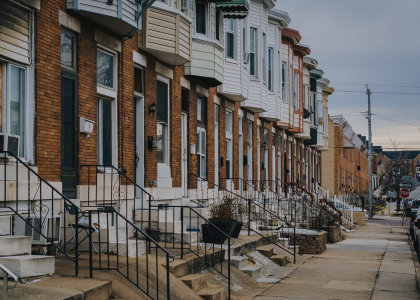Even before the COVID-19 era, commercial real estate had been wrestling with the existential questions of the future of office buildings. Businesses, from tech companies to financial firms, were rethinking the role of office space. More companies were developing telework policies, embracing shared office spaces, and downsizing headquarters. The pandemic has intensified some of these developments, proving to once-skeptical business managers that most—if not all—office work can be done virtually. It has also heightened the need for flexible office space, repurposed office space, more-efficient homes that accommodate telework, and healthier buildings.
Nora Wang Esram will be speaking about how COVID-19 is shaping the long-term outlook for indoor air quality, productivity, and efficiency on a webcast hosted by 75F at 2:00 p.m. ET today
Data reflect some of these ongoing shifts. While total commercial building floor space continued to grow in the past decade, the growth did not occur in traditional office and retail sectors, but rather in service (40%), public assembly (39%), lodging (35%), and warehouse and storage (26%), according to the Energy Information Administration’s 2018 Commercial Buildings Energy Consumption Survey. This provides evidence that offices and brick-and-mortar stores are facing disruptive challenges. In contrast, demand for lab space for life sciences (pharmaceutical, biotech, and other medical research fields) has been growing in many cities, while offices sit empty, according to the CBRE Real Estate Market Outlook.
Repurposing offices to labs and apartments
Prior to the pandemic, lab space in the United States had increased 170% in the past 10 years. The race for coronavirus therapies and vaccines has certainly further ramped up investment in lab space. In many areas, building owners have been converting offices to life-science facilities and to apartments, or turning empty stores to e-commerce fulfillment centers.
The upcoming wave of adaptive reuse presents huge building retrofit opportunities beyond normal tenant buildouts. Energy efficiency programs and policies should capture these opportunities to incentivize and support landlords and businesses to integrate building efficiency technologies and measures that are beyond the minimum code requirements for major renovations. These programs should not only aim to reduce building energy use, but also help building owners achieve greater flexibility to better adapt to unforeseen future changes.
The rise of flexible office space
The pandemic has also accelerated the demand for more flexibility in office space. In the short term, some offices have been redesigned for the new reality of social distancing. In the long term, more agile office spaces are needed to support the transformation of the office from a place where people spend their day working to a place where staff visit occasionally to collaborate, meet with clients, or retreat.
The uncertainty and fluctuation in occupant density make it more challenging to operate buildings if they are not equipped with energy management technologies and strategies. A few studies, for example by the University of California at Davis, Carbon Lighthouse, and hatchdata, have shown that empty office buildings during the COVID lockdown still consume a significant amount of energy (up to 100% of pre-lockdown use). In a more competitive real estate market where fewer tenants are willing to pay a hefty utility bill for a half-empty office, there will likely be more appetite for modular and more-efficient HVAC equipment, miscellaneous-load management, and building automation.
Teleworking’s impact on energy use
While energy sales in the commercial sector fell 11% during the first three months of the pandemic (April-June 2020), sales in the residential sector increased 8%, partly because of increased teleworking. A National Bureau of Economic Research study in April and May 2020 shows that half of the U.S. working population (employed pre-COVID19) worked from home. A growing share of the office labor force will gradually return to the office as more businesses and buildings are expected to resume in-person operation sometime this year. However, many workers may permanently remain working entirely or partially from home because of relaxed telework policies, enhanced infrastructure to support virtual communication, and the ultimate transformation of office space.
Increased telework will shift work-related energy costs and other expenses from employers to employees. Depending on commute means and distance, increased household energy bills may be offset by reduced commuting expenses for some employees. For those who had low commuting expenses (including costs covered by employee benefits supported with favorable tax policy), there will be a negative economic impact. Lawmakers and employers should develop policies to address this challenge. Employers could offer higher compensation, direct utility bill reimbursement, and alternatives to commuting benefits. But in the long term, they should look to reallocate funds previously spent on office facility costs (including rent and utilities) to finance employees’ home energy efficiency upgrades.
This presents great opportunities for residential energy retrofits. Homeowners will have more incentive to make their homes more efficient and more comfortable when they spend a great deal of time working there. Renters will choose more-efficient and comfortable apartments or houses over proximity to their work location. Energy efficiency programs and policies should leverage the desire for home repair and remodeling to stimulate residential building energy retrofits through education, incentives, workforce development, and financing.
Not only does teleworking increase household energy use, but it also changes the load pattern of the residential sector. A study of energy consumption in Texas shows that the energy load profile from April through July of 2020 was nearly identical across days of the weeks—every day is like Sunday! Demand management strategies for the residential sector must be calibrated to adapt to this new reality. Although challenging, the changing energy use pattern in homes could allow more households to participate in providing grid service (e.g., energy efficiency, demand response, distributed generation and storage) when equipped with in-home load coordination and management technologies. This will provide more opportunities for utilities and providers of smart home technologies and energy management systems to harness the power of homes for energy savings and load flexibility.
Moving toward heathier buildings
The COVID pandemic has raised public awareness of indoor air quality (IAQ) and generated a wave of research, products, and services for public health. For the first time, many tenants are asking about ventilation rates and demanding safety measures. As landlords and building managers seek solutions to reduce viral spread in buildings, vendors are introducing all kinds of services and products, from HEPA filters to germicidal lights that have been primarily used in hospitals or clean rooms (note that for some of these products, there is little evidence to support their effectiveness in reducing viral transmission). Although dilution, filtration, and source control are proven IAQ management methods, over-ventilation, super high filtration, and excess outdoor air intake without proper strategies will increase energy demand, overload equipment, and potentially cause more harm to occupants.
There is little conflict between improving IAQ and reducing energy use if done correctly. The public interest in and tenants’ demand for healthy indoor environment can create opportunities for building retro-commissioning, automation, and retrofit. HVAC systems should provide ASHRAE Standard 62.1 and similar code-compliant ventilation rates. Governments and utilities can develop incentives and technical assistance programs that combine public health with energy efficiency. Such cross-cutting programs need federal and local champions to drive collaborations among health departments, municipal buildings departments, and state energy and resources agencies. These programs could help building and business owners upgrade with high-efficiency equipment, variable speed drives, demand control ventilation, dedicated outdoor air systems, and advanced controls and automation to improve comfort and occupant health, while saving energy and reducing carbon emissions.
Schools, senior care centers, and other buildings used for public assembly—especially those for vulnerable populations or with aging facilities—need special attention. The recent $900 billion federal relief package provides $54 billion for the Elementary and Secondary School Emergency Relief (ESSER) fund. Congress authorized ESSER funds to be used to repair and improve school facilities to reduce the risk of virus transmission and exposure to environmental health hazards. As a recent ACEEE blog post notes, “The need to improve HVAC systems in response to COVID-19 comes at a time when school facilities are already grappling with an enormous backlog of projects to address deferred maintenance and overdue capital improvements.” Local education agencies, which will receive at least 90% of the ESSER funding, can use help from the Department of Energy and other energy organizations to develop school upgrade plans for longer-term benefits in the wake of COVID-19.



